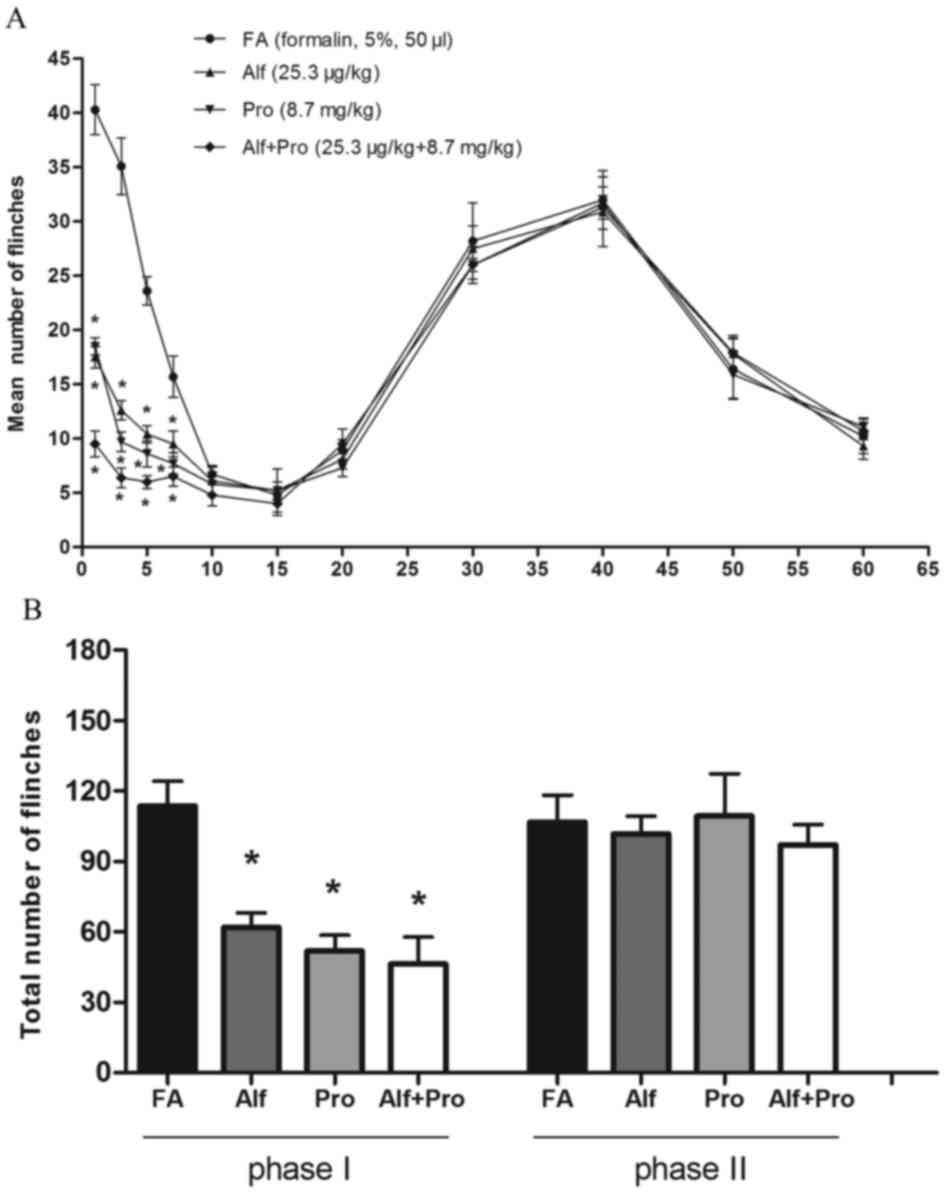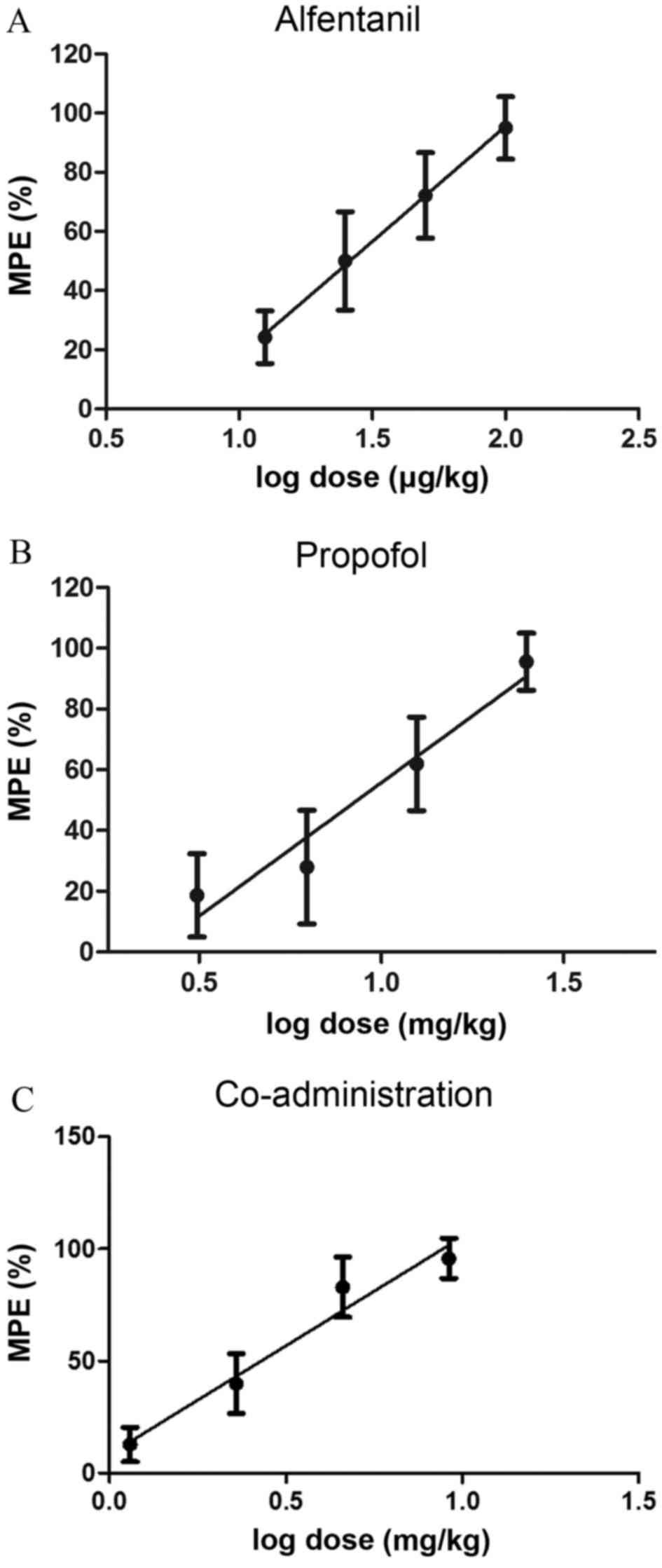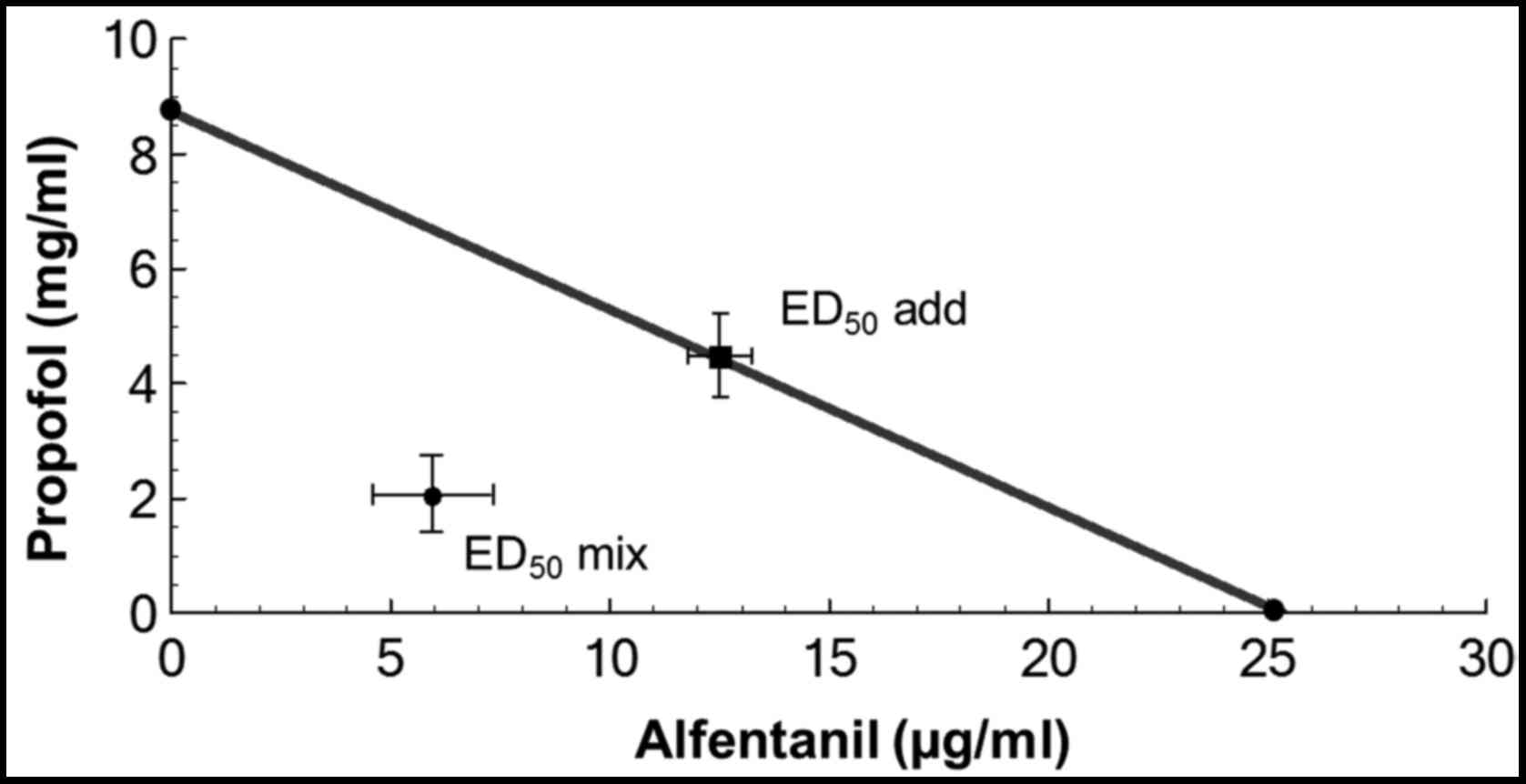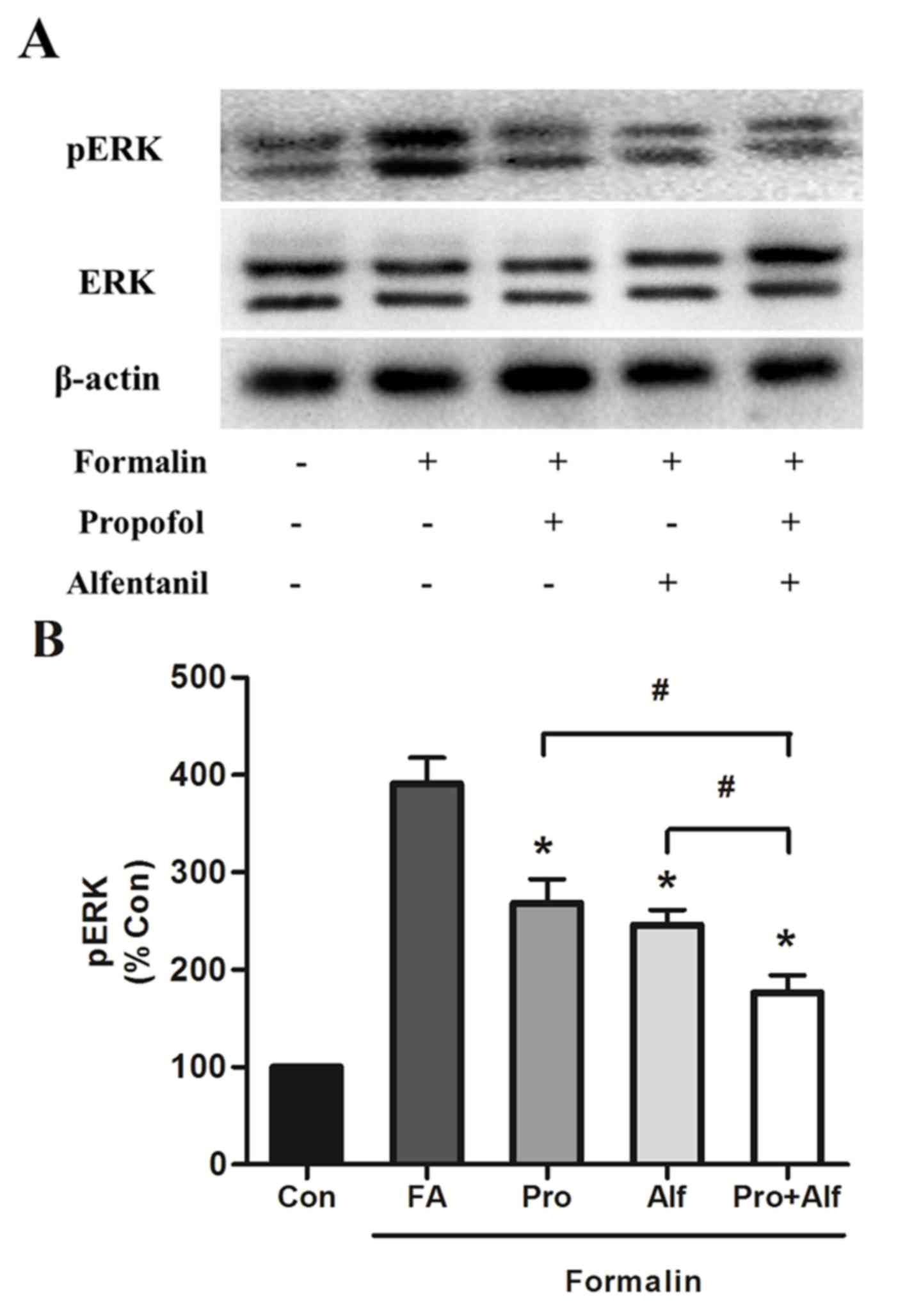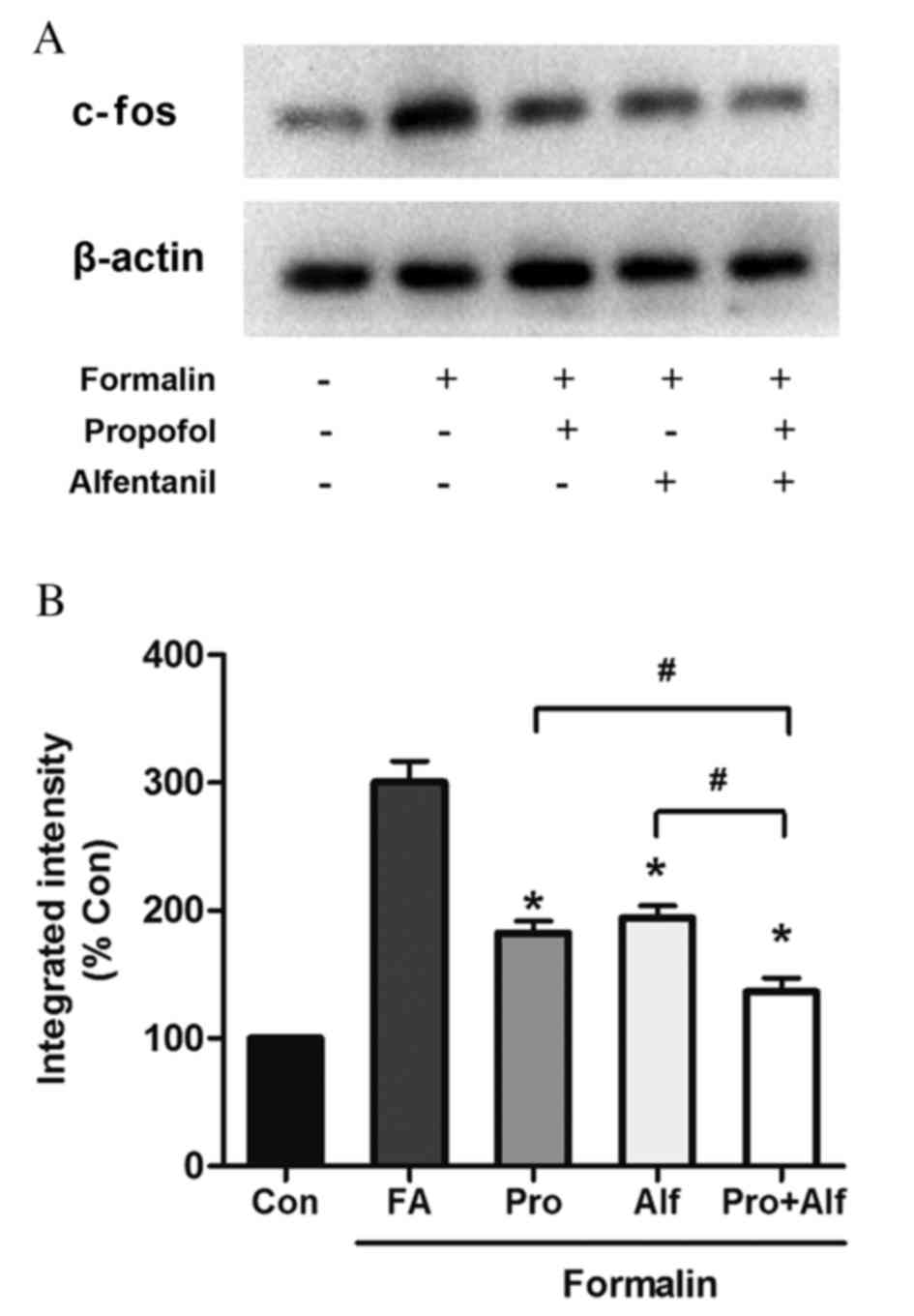Synergistic antinociceptive effects of alfentanil and propofol in the formalin test
- Authors:
- Published online on: February 7, 2017 https://doi.org/10.3892/mmr.2017.6174
- Pages: 1893-1899
Abstract
Introduction
Combinations of drugs that have similar effects have been employed clinically. Of the three types of drug interactions that can occur (synergism, additivity and antagonism), synergism is preferred as it allows lower doses of each drug to be used, which reduces the risk of any potential side effects is reduced (1). Clinically, combinations of opioid analgesics and intravenous anesthetics are used to establish balanced anesthesia and to reduce side effects, including earlier recovery and less postoperative nausea and vomiting. Opioids have long been used for the treatment of pain and are one of the most commonly prescribed drugs for pain management. They act through three receptors, termed µ, κ and δ opioid receptors. Opioid receptors are enabled by endogenously produced peptides, such as morphine, and opioid drugs, including fentanyl. Of these, the µ opioid receptor has an important role as the mediator of the majority of the effects of most clinically used opioids (2). Alfentanil is a short-acting synthetic opioid analgesic drug that targets µ opioid receptors and is ~4-fold faster than fentanyl in terms of the onset of effects (3). Opioid agonists are effective analgesic drugs and are irreplaceable in the treatment of inflammatory and severe pain (4).
Propofol is a widely used intravenous general anesthetic. It is reported to function at a specific site in γ-aminobutyric acid-A receptors (GABAAR) and functions as a positive allosteric modulator or an agonist (5). It is indistinct from the analgesic actions of propofol despite its anesthetic effects. Gilron et al (6) reported that propofol reduced hind paw formalin-induced expression of fos-like immunoreactivity in spinal neurons. The results of the study indicated the analgesic effect of propofol. Our previous research demonstrated the analgesic effects of propofol in several animal models (7). Sun et al (8) previously demonstrated the peripheral antinociceptive effect of propofol in an inflammatory pain model.
Extracellular signal-regulated kinase (ERK) is a mitogen-activated protein kinase (MAPK) subfamily member. It is activated in spinal dorsal horn neurons in response to injury and inflammation-induced hyperalgesia of the peripheral tissue, with similar results in a murine model of visceral pain (9,10). Furthermore, it is known that c-fos is an immediate early gene and a downstream target of ERK. C-fos is recognized as a marker for stimulus-induced changes in the activity of neurons. It is induced in the central nervous system under various conditions, including in response to inflammatory and painful stimuli (11). ERK and c-fos are expressed in the spinal cord and are important for nociception.
Alfentanil combined with propofol is a promising combination for total intravenous anesthesia. It is well established that propofol and alfentanil synergistically suppress pain in clinical and animal experiments (7,12). However, to the best of our knowledge, no study has investigated the synergistic antinociceptive effects and potential mechanism of alfentanil and propofol on tonic inflammatory pain. The present study proposed that formalin-triggered behavioral responses may be synergistically inhibited by a combination of alfentanil and propofol, and that this would be associated with the ERK and c-fos signaling pathway. The type of interaction (synergism, additivity or antagonism) between alfentanil and propofol was evaluated by isobolographic analysis.
Materials and methods
Animals
All experiments were performed in adherence with the guidelines for the care and use of laboratory animals (13) and were approved by the Fourth Military Medical University Committee on Animal Care (Xi'an, China). Animal treatments were performed according to the ethical guidelines of the International Association for the Study of Pain (14) for the investigation of experimental pain in conscious animals. Male Sprague Dawley rats (n=24; 7 weeks, 150–220 g) were obtained from the animal research center at the Fourth Military Medical University. The rats were raised in individual standard cages and maintained on a 12 h light/dark cycle (lights on at 07:00 a.m.) at 22°C. Testing was performed during the light cycle. Food and water were available ad libitum. Each animal was restrainer-trained and habituated to the test environment for 1 week prior to testing.
Reagents and antibodies
Alfentanil (cat. no. 20151009; Hubei Gedian Humanwell Pharmaceutical Co., Ltd., Wuhan, China) was suspended in propylene glycol (XiLu Chemical Co., Ltd., Guangzhou, China) and diluted with propofol (10 mg/ml; cat. no. p028104; diprivan; AstraZeneca, London, UK) to obtain the desired concentrations of the drug. Rabbit p44/42 MAPK (ERK1/2; 137F5) antibody (cat. no. 4695; 1:1,000), rabbit phospho-p44/42 MAPK [phosphorylated ERK1/2 (pERK); Thr202/Tyr204] antibody (cat. no. 4376; 1:1,000) and rabbit c-fos antibody (cat. no. 2250; 1:1,000) were purchased from Cell Signaling Technology, Inc. (Danvers, MA, USA). Unless otherwise stated, all other chemicals were purchased from Sigma-Aldrich (Merck Millipore, Darmstadt, Germany).
Formalin test
The paw formalin test is a well-characterized experimental model of nociception and was performed as described previously (15). Following intraplantar injection of formalin solution (5%; 50 µl) into the right hind paw, 24 rats (n=6 per group) were placed in individual clear plastic cages (22×12×12 cm). Before the start of the experiments, the animals were acclimatized to the laboratory environment for at least one week. Flinching behavior was considered to be an expression of nociception. Time courses of antinociceptive responses resulting from the administration of different drugs were constructed by plotting the mean number of flinches as a function of time. The typical time course of the response to formalin is biphasic, with an early and short-lasting first phase followed, after a quiescent period, by a second, prolonged (tonic) phase. While phase I is considered to reflect acute nociceptive pain due to a direct stimulation of the nerve by formalin, phase II is attributed to the combination of ongoing inflammatory-associated afferent input from peripheral tissue and functional changes in the spinal dorsal horn (central sensitization) (16). Flinching was defined as rapid and brief withdrawal or flexing of the injected paw, lifting, licking and rubbing behavior. The time-response data were presented as the total number of flinches. To determine the ED50 values of each drug, the number of flinches was converted to the percentage of maximum possible effect (% MPE) according to the formula:
MPE (%)=100-(Sum of flinching count with drug/Sum of control flinching count)x100.
Isobolographic analysis
The up-and-down method was used to determine the median effective analgesic dosages of alfentanil and propofol administered either alone, or in combination. Certain groups of animals (n=6 per group) were treated intravenously with various concentrations of either alfentanil (5, 10, 20 and 40 mg/kg) or propofol (2.5, 5, 10 and 20 mg/kg) 10 min prior to formalin injection. The alfentanil-propofol combination was also administered intravenously at increasing doses (0.5, 1, 2 and 4 mg/kg). Control animals were given saline and were interspersed concurrently with the drug-treated animals. The volumes administered were 4 ml/kg. Rats in all groups were observed for changes in behavior that may have been induced by the treatments. In the present study, the initial dosages of alfentanil and propofol were determined according to preliminary experiments and literature values (7,17). Dose-response curves were constructed using least-squares linear regression using the Pharm Tools Pro software (version no. 1.1.27; The McCary Group, Inc., Lehigh Valley, PA, USA). Following the assessment of antinociception for each drug, experimental median effective dose (ED50) values for each drug were determined. Subsequently, a dose-response curve was obtained by concurrent delivery of alfentanil and propofol in a fixed-ratio mixture (1:150), which was based on the ED50 values of each individual agent. The ratio of the two drugs was obtained from our previous study (18).
To construct the experimental antinociceptive effect-dose curve, each group of rats received one of the following doses of the drug combination: Alfentanil ED50 (25.3 µg/kg)+propofol ED50 (8.7 mg/kg); alfentanil ED50/2 (12.65 µg/kg)+propofol ED50/2 (4.35 mg/kg); alfentanil ED50/4 (6.33 µg/kg)+propofol ED50/4 (2.18 mg/kg); alfentanil ED50/8 (3.17 µg/kg)+propofol ED50/8 (1.09 mg/kg) or alfentanil ED50/16 (1.59 µg/kg)+propofol ED50/16 (0.55 mg/kg). The experimental ED50 value for the alfentanil-propofol combination was calculated from this curve. For drug combinations, experimental ED50 (ED50 mix) and its associated 95% confidence intervals (CIs) were determined by linear regression analysis of the log dose-response curve and compared with a theoretical additive ED50 (ED50 add) obtained from the calculation: ED50 add=fxED50 alfentanil + (1-f)xED50 propofol, where f denotes a fraction of the corresponding ED50 in drug mixture (in the present study, f=0.5). In this equation (17,18), ED50 add is the total dose, and the variance of ED50 add was calculated as follows: Var ED50 add=f2 × Var ED50 alfentanil+ (1 -f)2x Var ED50 propofol.
From these variances, CIs were calculated and resolved according to the ratio of the individual drug in the combination. When the drug combination gives an experimental ED50 not statistically different from the theoretical calculated ED50, the combination has an additive effect. If the mixture ED50 lies on the theoretical additive ED50 line, or the confidence intervals overlap that line, then the mixture is considered to be additive. If the mixture ED50 lies below the theoretical additive ED50 line and the confidence intervals do not overlap that line, the mixture is considered to be synergistic. The theoretical and experimental ED50 values of the combinations were also contrasted by calculating the interaction index (γ). This was calculated as ED50 mix/ED50 add. If the value is ~1, the interaction is additive. Values <1 are an indication of the magnitude of supra-additive or synergistic interactions, and values >1 correspond to sub-additive or antagonistic interactions (19–22).
Protein preparation and measurement
The behavioral test was performed on the following 5 groups of rats following formalin injection (5%; 50 µl; n=6 per group): Group FA (rats received formalin and an equal volume of saline vehicle); group Alf (rats received formalin and alfentanil at dose of 25.3 µg/kg); group Pro (rats received formalin and propofol at dose of 8.7 mg/kg); group Alf + Pro (rats received formalin, alfentanil-propofol combination at dose of 2.51 mg/kg); control group rats received an equal volume of saline vehicle only. The dosage of alfentanil or propofol alone was ED50. The dosages of combination of alfentanil and propofol were ED5.
To evaluate pERK protein levels, rats were sacrificed 30 min after drug treatment. For the measurement of c-fos protein expression, rats were sacrificed 60 min after drug treatment. Rats were anesthetized intraperitoneally with 40 mg/kg sodium pentobarbital, and perfused with fresh 4% paraformaldehyde in 0.1 M phosphate buffer (pH 7.4). Following decapitation, after a brief 20 sec exposure to CO2, rat spinal cord L5-L6 segments were excised, spinal meninges removed and tissue dissociated mechanically, and stored at −80°C until detection. Tissue samples were homogenized by using a Polytron handheld homogenizer (Kinematica, Luzern, Switzerland) in lysis buffer (50 mM Tris-HCl; 150 mM NaCl; 2 mM EDTA; 10% glycerol; 1% Triton X-100; 1% Igepal CA-630; 1% sodium deoxycholic acid). After 30 min incubation, homogenates were centrifuged at 12,000 × g for 15 min at 4°C. Supernatants were then collected and stored at −80°C until used. Total protein content was determined using a Bradford kit from Bio-Rad Laboratories, Inc. (Hercules, CA, USA).
Western blot analysis
Western blot assay was performed as previously described (21). Aliquots of total protein samples (50 µg) were separated on a 10% SDS-PAGE gel and transferred onto a nitrocellulose membrane. The filter membranes were blocked with 5% non-fat milk for 1 h at room temperature and incubated with the primary antibody specific for pERK1/2 or total ERK1/2 (1:1,000 dilution) and c-Fos (1:1,000 dilution). The membrane was washed with 0.05% TBS Tween buffer and incubated for 1 h with the secondary antibody conjugated with horseradish peroxidase (Goat anti-horseradish peroxidase; cat. no. 123-005-021, 1:1,000; Jackson ImmunoResearch Laboratories, Inc., West Grove, PA, USA) for 1 h at room temperature and visualized in ECL solution (cat. no. 1705060; Bio-Rad Laboratories, Inc., Hercules, CA, USA). for 1 min, followed by film exposure for 1–10 min. The loading and blotting of equal amounts of proteins were verified by re-probing the membrane with antibody against β-actin (1:1,000; cat. no. sc-47778, Santa Cruz Biotechnology, Inc., Dallas, TX, USA). The intensity of each immunoblot assay band was quantified using a VersaDoc Imaging System (Bio-Rad Laboratories, Inc.). The experiments were repeated twice. Quantification of immunoreactivity corresponding to the total and phosphorylated bands was performed by densitometric analysis using Multi Gauge Version 3.0 (Fujifilm, Tokyo, Japan).
Statistical analysis
Results were presented as the mean ± standard error of the mean or as ED50 values with 95% CIs. The statistical significance of dose-responses was determined by one-way analysis of variance followed by the Tukey's post hoc test. Isobolographic calculations were performed by using the Pharm Tools Pro software (version no. 1.1.27, The McCary Group, Inc.). Statistical analysis of the isobolograms was performed as previously described (22) and differences between experimental and theoretical values were assessed by Student's unpaired t-test. P<0.05 was considered to indicate a statistically significant difference.
Results
Antinociceptive effect of alfentanil and propofol
Plantar injection of formalin produces nociceptive behavior, including flinches of the paw. Flinching was defined as rapid and brief withdrawal or flexing of the injected paw, lifting, licking and rubbing behavior. In the present study, the number of pain responses in 5 min intervals during phase I, for 20 min, and 10 min intervals during phase II, for 40 min, following formalin injection was recorded. Saline-treated control rats exhibited discrete biphasic behavioral responses consisting of an early short-lasting response (phase I, 0–10 min post-injection), followed by a late, prolonged response (phase II, ~16–60 min post-injection). The duration of licking, lifting and rubbing were considered to be nociceptive behaviors in the formalin model. The mean number of flinches peaked around 0–10 min and 30–50 min after formalin intraplantar injection, which was followed by a gradual decline in all groups (Fig. 1A). Nociceptive behavior, the mean number of flinches, between saline and drug-treated groups was compared. There were no significant differences between any of the groups during phase II of the behavioral response. However, the amount of licking and lifting behavior was reduced in the alfentanil or propofol alone groups, and alfentanil-propofol combination group for the first 5 min after formalin injection, compared with the saline group during phase I (P<0.05; Fig. 1A). The total numbers of flinches during phase I and phase II following formalin injection in the saline treatment group was 121.4±8.8 and 100.5±12.1, respectively. However, compared with the saline treatment group, the total number of flinches was significantly decreased in groups Alf (56.1±5.3), Pro (50.3±5.0) and Alf+Pro (33.2±4.6) during phase I (P<0.05; Fig. 1B). There were no significant differences between any of the groups during phase II.
Isobolographic analysis for drug combination
In phase I, alfentanil, propofol and alfentanil-propofol combination groups led to a dose-dependent antinociceptive effect. Linear regressions for alfentanil (Y=186.0X-24.7; R2=0.9861), propofol (Y=153.7X-10.92; R2=0.9728) and co-administration (Y=91.97X+8.55; R2=0.9962) were calculated by plotting MPE (%) against the log dose (Fig. 2). The ED50 of individual administration of alfentanil and propofol were 25.3±2.21 µg/kg and 8.7±1.344 mg/kg, respectively (Table I). The isobologram was constructed by connecting the ED50 of alfentanil on the abscissa with the ED50 of propofol on the ordinate to obtain the additive line (Fig. 3). For the drug combination, the ED50 mix and the 95% CI of the mixture were computed by linear regression of the log dose-response curve. The ED50 mix and ED50 add were plotted in the isobologram (Fig. 3). The fixed drug-dose ratio based on mass quantity for alfentanil and propofol is 1:344. The total ED50 mix for the alfentanil-propofol combination is 2.51±0.56 mg/kg (Table I), representing 7.27 µg/kg alfentanil and 2.50 mg/kg propofol. By isobolographic analysis, the ED50 add=4.36 mg/kg [(0.5xED50 alfentanil) + (0.5xED50 propofol)] (Table I), representing 12.64 µg/kg alfentanil plus 4.35 mg/kg propofol. The ED50 mix was <ED50 add (Table I). The γ value was 0.57, which suggests a synergistic interaction between alfentanil and propofol during phase I of the formalin test (Table I).
Table I.ED50 and interaction index of alfentanil, propofol, and alfentanil-propofol combination in the formalin test in rats. |
Effects of alfentanil-propofol combination on ERK and c-fos expression
The expression of total and phosphorylated-ERK (Fig. 4), and c-fos (Fig. 5) in control and drug-treated groups was detected. Compared with the β-actin bands, the ratios of the optical density of total ERK bands in all groups were not significantly different. To investigate the expression level of the two proteins, the ratio of the optical density of each band for phosphorylated and total proteins were detected, and values were normalized as a percentage of the control group. The effect of drug treatment on total and pERK expression was determined in spinal cord L4-L5 segments of the lumbar enlargement, areas that are involved in the transmission of nociceptive inputs and the control of sympathetic outflow (23). In the present study, two bands, p42 and p44, represented ERK and were analyzed. Concerning ERK activation, there was no significant change in the expression of total-ERK following formalin addition (Fig. 4). However, formalin induced the activation of pERK, which was significantly reduced when subsequently treated with alfentanil (P=0.02) or propofol (P=0.03) alone, or combination treatment (P=0.01), compared with the formalin only group (FA). Furthermore, formalin-induced activation was significantly reduced by combination treatment (Pro + Alf) compared with those treated with propofol (P=0.01) or alfentanil (P=0.03) only groups (Fig. 4). The current study subsequently investigated whether propofol and alfentanil had any effect on basal levels of c-fos expression. As illustrated in Fig. 5, there was a clear increase in the expression of c-fos following injection of formalin, highlighted in the FA group. This increased the level of c-fos expression was then significantly reduced when treated with alfentanil (P=0.02), propofol (P=0.02) or combination treatment (P=0.03) compared with the FA group. Notably, the Alf+Pro group also exhibited significantly decreased c-fos expression when compared with treatment with alfentanil (P=0.01) or propofol (P=0.02) alone (Fig. 5).
Discussion
The major finding of the current study was that the combination of alfentanil and propofol led to synergistic antinociceptive effects in the formalin test. Subcutaneous hind paw injection of formalin triggers biphasic nociceptive responses. While phase I is considered to reflect acute nociceptive pain due to direct stimulation of the nerve by formalin, phase II is attributed to the combination of ongoing inflammatory-associated afferent input from peripheral tissue and functional changes in the spinal dorsal horn (central sensitization) (24). Accordingly, the present study investigated the inhibitory effects of alfentanil or propofol on the number of flinches in a given time following formalin injection, flinches were considered to indicate a nociceptive response. Injection of formalin led to persistent inflammatory pain throughout the test. The current study observed that nociceptive behavior during phase I, but not phase II, was reduced when treated with alfentanil, propofol or both. Furthermore, it was established that combined treatment with alfentanil and propofol led to synergistic antinociceptive effects. The present study calculated the ED50 mix of the alfentanil-propofol combination in phase I of the formalin test. The ED50 for treatment with alfentanil or propofol alone were calculated as 25.3±2.21 µg/kg and 8.7±1.344 mg/kg, respectively. The ED50 mix was significantly less than their corresponding ED50 add, and the calculated interaction index (γ) was <1. The results of this study initially demonstrated the synergistic interaction between alfentanil and propofol in the formalin test. Notably, the ED50 of propofol in the formalin test was less than its ED50 for clinical application, suggesting that the synergistic antinociceptive effect may potentially be beneficial for its use in clinic for pain treatment.
A previous study reported that propofol at sub-hypnotic dosage (0.25 mg/kg) reduced acute pain induced by argon laser stimulation in humans (24). Furthermore, a study that involved healthy volunteers suggested that propofol delivered intravenously, at 0.25 mg/kg followed by 25 µg/kg/min or more, led to a reduction in pain intensity (25). Additionally, another study demonstrated that intravenously administered propofol (0.25–0.5 mg/kg) depressed pain induced by tibial pressure algesimetry in patients who had been through gynecologic surgery (26). However, one study concluded that propofol (0.5 mg/kg) did not affect thermal pain detection thresholds (27). In the current study, the ED50 of propofol was calculated to be 8.7±1.344 mg/kg in a formalin test performed on rats. Propofol is a commonly used intravenous general anesthetic that acts on GABAAR and enhances the action of GABA. It is indistinct from the analgesic actions of propofol despite its profound anesthetic effects. Goto et al (28) concluded that propofol had no effect on phase II nociceptive behavioral responses induced by formalin injection in the hind paw of rats. However, Gilron et al (6), reported that propofol reduced hind paw formalin-induced expression of fos-like immunoreactivity in spinal neurons. Their results indicated the analgesic effect of propofol. Antinociceptive effects of propofol have previously been reported in humans (24). It is suggested, based on in vivo studies, that propofol reduced pain in rats via spinal GABAARs (29,30). Alfentanil is an analgesic that acts as an agonist of µ opioid receptors and it is used to relieve acute pain or the severe, chronic and disabling pain associated with terminal conditions, including cancer and degenerative conditions, which include rheumatoid arthritis. The analgesic effects of alfentanil and propofol are regulated through different receptors at the level of the spinal cord. However, the synergistic antinociceptive effects of their combined treatment and the underlying molecular mechanisms of alfentanil and propofol in acute nociceptive pain remain unclear. The current study demonstrated that the synergistic antinociceptive action of alfentanil and propofol in the formalin test is regulated by ERK1/2 and c-fos, as described above (Figs. 4 and 5) (9,10). Further studies are required to investigate the mechanism in further detail.
In summary, the present research suggests synergism between alfentanil and propofol. These results provide evidence for the potential benefits that the development of synergistic drug combinations of opioid analgesics with intravenous anesthetics may have if applied clinically. The combination of alfentanil with propofol may prove beneficial for the treatment of pain, including neuropathic or anti-inflammatory disease. Furthermore, the combination of alfentanil and propofol treatments may produce synergistically antinociceptive effects through inhibition of pERK1/2 and decreased expression of c-fos in the spinal cord.
Acknowledgements
This study was financially supported by grants from the National Nature Science Foundation of China (grant no. 81403159) and the National New Drug ‘R&D’ project (grant no. 2011ZXJ09302).
References
|
Hendrickx JF, EI II Eger, Sonner JM and Shafer SL: Is synergy the rule? A review of anesthetic interactions producing hypnosis and immobility. Anesth Analg. 107:494–506. 2008. View Article : Google Scholar : PubMed/NCBI | |
|
Kieffer BL and Evans CJ: Opioid receptors: From binding sites to visible molecules in vivo. Neuropharmacology. 56 Suppl 1:S205–S212. 2009. View Article : Google Scholar | |
|
Hug CC, Chaffman M, Camu F and Spierdijk J: Alfentanil: Pharmacology and uses in anaesthesia. Adis. 1984. | |
|
Taylor BK, Peterson MA, Roderick RE, Tate J, Green PG, Levine JO and Basbaum AI: Opioid inhibition of formalin-induced changes in plasma extravasation and local blood flow in rats. Pain. 84:263–270. 2000. View Article : Google Scholar : PubMed/NCBI | |
|
Smith I, White PF, Nathanson M and Gouldson R: Propofol. An update on its clinical use. Anesthesiology. 81:1005–1043. 1994. View Article : Google Scholar : PubMed/NCBI | |
|
Gilron I, Quirion R and Coderre TJ: Pre- versus postinjury effects of intravenous GABAergic anesthetics on formalin-induced Fos immunoreactivity in the rat spinal cord. Anesth Analg. 88:414–420. 1999. View Article : Google Scholar : PubMed/NCBI | |
|
Wu Y, Jia N, Zhao C, Li Y, Shi XP, Li YW, Wang C, Li RL, Wang JW and Wen AD: Synergistic antinociception of propofol-alfentanil combination in mice. Pharmacol Biochem Behav. 116:25–29. 2014. View Article : Google Scholar : PubMed/NCBI | |
|
Sun YY, Li KC and Chen J: Evidence for peripherally antinociceptive action of propofol in rats: Behavioral and spinal neuronal responses to subcutaneous bee venom. Brain Res. 1043:231–235. 2005. View Article : Google Scholar : PubMed/NCBI | |
|
Ji RR, Befort K, Brenner GJ and Woolf CJ: ERK MAP kinase activation in superficial spinal cord neurons induces prodynorphin and NK-1 upregulation and contributes to persistent inflammatory pain hypersensitivity. J Neurosci. 22:478–485. 2002.PubMed/NCBI | |
|
Hunt SP, Pini A and Evan G: Induction of c-fos-like protein in spinal cord neurons following sensory stimulation. Nature. 328:632–634. 1987. View Article : Google Scholar : PubMed/NCBI | |
|
Morgan JI and Curran T: Stimulus-transcription coupling in neurons: Role of cellular immediate-early genes. Trends Neurosci. 12:459–462. 1989. View Article : Google Scholar : PubMed/NCBI | |
|
Vuyk J, Engbers FH, Burm AG, Vletter AA, Griever GE, Olofsen E and Bovill JG: Pharmacodynamic interaction between propofol and alfentanil when given for induction of anesthesia. Anesthesiology. 84:288–299. 1996. View Article : Google Scholar : PubMed/NCBI | |
|
Vogel HG, et al: Guidelines for the care and use of laboratory animalsDrug Discovery and Evaluation. Springer; Berlin Heidelberg: pp. 2023–2037. 2007, View Article : Google Scholar | |
|
Wood MM and Cousins MJ: Iatrogenic neurotoxicity in cancer patients. Pain. 39:1–3. 1989. View Article : Google Scholar : PubMed/NCBI | |
|
Cho IH, Chung YM, Park CK, Park SH, Lee H, Kim D, Piao ZG, Choi SY, Lee SJ, Park K, et al: Systemic administration of minocycline inhibits formalin-induced inflammatory pain in rat. Brain Res. 1072:208–214. 2006. View Article : Google Scholar : PubMed/NCBI | |
|
Tjølsen A, Berge OG, Hunskaar S, Rosland JH and Hole K: The formalin test: An evaluation of the method. Pain. 51:5–17. 1992. View Article : Google Scholar : PubMed/NCBI | |
|
Guindon J, LoVerme J, Piomelli D and Beaulieu P: The antinociceptive effects of local injections of propofol in rats are mediated in part by cannabinoid CB1 and CB2 receptors. Anesth Analg. 104:1563–1569. 2007. View Article : Google Scholar : PubMed/NCBI | |
|
Jia N, Zhao C, Wang L, Li Y, Cui J, Cao S, Li R, Wang C, Wu Y and Wen A: The effects of a propofol/alfentanil admixture on total intravenous anaesthesia in dogs undergoing splenectomy. Veterinární Medicína. 60:194–201. 2015. View Article : Google Scholar | |
|
Tallarida RJ, Stone DJ Jr and Raffa RB: Efficient designs for studying synergistic drug combinations. Life Sci. 61:PL417–PL425. 1997. View Article : Google Scholar | |
|
Tomić MA, Vucković SM, Stepanović-Petrović RM, Ugresić ND, Prostran MS and Bosković B: Synergistic interactions between paracetamol and oxcarbazepine in somatic and visceral pain models in rodents. Anesth Analg. 110:1198–1205. 2010.PubMed/NCBI | |
|
Tallarida RJ: Drug synergism: Its detection and applications. J Pharmacol Exp Ther. 298:865–872. 2001.PubMed/NCBI | |
|
Tallarida RJ: The interaction index: A measure of drug synergism. Pain. 98:163–168. 2002. View Article : Google Scholar : PubMed/NCBI | |
|
Fürst S: Transmitters involved in antinociception in the spinal cord. Brain Res Bull. 48:129–141. 1999. View Article : Google Scholar : PubMed/NCBI | |
|
Anker-Møller E, Spangsberg N, Arendt-Nielsen L, Schultz P, Kristensen MS and Bjerring P: Subhypnotic doses of thiopentone and propofol cause analgesia to experimentally induced acute pain. Br J Anaesth. 66:185–188. 1991. View Article : Google Scholar : PubMed/NCBI | |
|
Zacny JP, Coalson DW, Young CJ, Klafta JM, Lichtor JL, Rupani G, Thapar P and Apfelbaum JL: Propofol at conscious sedation doses produces mild analgesia to cold pressor-induced pain in healthy volunteers. J Clin Anesth. 8:469–474. 1996. View Article : Google Scholar : PubMed/NCBI | |
|
Briggs LP, Dundee JW, Bahar M and Clarke RS: Comparison of the effect of diisopropyl phenol (ICI 35, 868) and thiopentone on response to somatic pain. Br J Anaesth. 54:307–311. 1982. View Article : Google Scholar : PubMed/NCBI | |
|
Wilder-Smith OH, Kolletzki M and Wilder-Smith CH: Sedation with intravenous infusions of propofol or thiopentone Effects on pain perception. Anaesthesia. 50:218–222. 1995. View Article : Google Scholar : PubMed/NCBI | |
|
Goto T, Marota JJ and Crosby G: Pentobarbitone, but not propofol, produces pre-emptive analgesia in the rat formalin model. Br J Anaesth. 72:662–667. 1994. View Article : Google Scholar : PubMed/NCBI | |
|
Nadeson R and Goodchild CS: Antinociceptive properties of propofol: Involvement of spinal cord gamma-aminobutyric acid(A) receptors. J Pharmacol Exp Ther. 282:1181–1186. 1997.PubMed/NCBI | |
|
Merrill AW, Barter LS, Rudolph U, EI II Eger, Antognini JF, Carstens MI and Carstens E: Propofol's effects on nociceptive behavior and spinal C-Fos expression after intraplantar formalin injection in mice with a mutation in the gamma-aminobutyric acid-type(A) receptor beta3 subunit. Anesth Analg. 103:478–483. 2006. View Article : Google Scholar : PubMed/NCBI |



